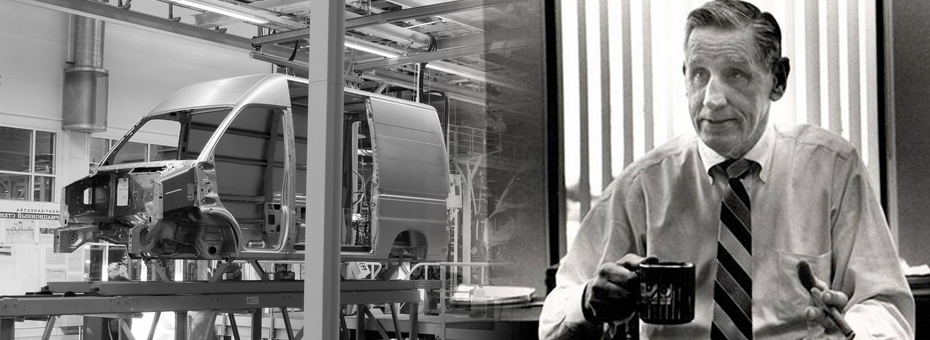Photo courtesy of Detroit Free Press/AP Photo
We in the Lean Community stand on a lot of shoulders. One broad pair belonged to Jim Harbour, who passed away last Saturday at age 86. While unknown to many in this generation of lean thinkers, Jim deserves to be remembered for his contribution to the movement at an early point in the spread of lean thinking to North America.
Jim learned about TPS largely by accident because Chrysler, where he was a manufacturing executive, needed high-mileage small cars after the first energy crisis in 1973 and didn’t have the funds to develop them on its own. It therefore formed a partnership with Mitsubishi to develop what became the Omni and Horizon models. Jim was sent to Japan and to the Mitsubishi plant in Australia to understand how Mitsubishi – which had carefully studied Toyota methods after the energy crisis as well – did its work. This was so Chrysler could build similar products in the US. He learned a great deal and not at all what he had expected.
Auto executives in Detroit until this time were united in denial about Japanese competitive success. The conventional wisdom was that dramatic Japanese gains in market share in export markets were the result of a weak currency through manipulation, strategic targeting by the Ministry of International Trade and Industry and the Ministry of Finance, secret re-work factories to get quality up to international standards, and suppliers and their workers living on starvation wages.
But Jim analyzed the problem using a very different method: In his visits to the Mitsubishi shop floor (which we now all call the gemba), he observed in great detail how they did the work of making a car. And, as it turned out, they managed this work in a very different and better way they had recently learned by observing Toyota. Jim concluded that they were much more productive in the use of labor and equipment than Chrysler and that their quality advantage was based on building in quality at the source rather than rework at the end of the line.
Jim brought this knowledge home and tried to explain it to anyone who would listen. But most managers were sticking with their more comfortable world view that required politicians in Washington to do something (e.g., Ronald Regan’s Voluntary Restraint Agreement on Japanese imports in 1981) but not auto executives in Detroit. Jim was nothing if not persistent and kept pushing his views about the need for a new approach to American manufacturing to a point that he was soon no longer working for Chrysler.
Instead he was working as a contractor to the U.S. Department of Transportation Volpe Center in Cambridge, Mass. as it studied the competitive position of Chrysler, which the government had bailed out in 1978 with a massive loan. In collaboration with Dr. Richard John, John O’Donnell (now at LEI), and Marty Anderson, one of my co-authors of the 1984 MIT book, The Future of the Automobile, he developed the report to the US Congress in 1981 that showed a $1,500 landed cost advantage for Japanese producers of small cars and traced this to differences in the way the Japanese and American companies designed and made cars. (One of Jim’s other talents was simple product cost calculations that cut through the accounting thicket in the car companies, most of which did not know their own costs.)
After the DOT work was done, Jim decided to create a consulting business – Harbour and Associates – to help any manufacturing company willing to listen in the adoption of lean methods. Its most visible product was the Harbour Report that estimated the productivity of American and Japanese car companies, assigned the differences to management and operating practices, and tracked the trends on an annual basis.
We used Jim’s work extensively at MIT in the analysis behind The Future of the Automobile and had a very productive relationship. I say this despite my clear memories of Jim arriving for our meetings with his signature cigar and scowl and with his clear insinuation that anyone who hadn’t worked in a factory for 30 years – as Jim had and we hadn’t – couldn’t really know anything!
As the transplants started to arrive in North America and Jim documented their ability to match the productivity and quality of their mother plants in Japan, Jim and the Harbour Report became household words in the manufacturing community. They were also an inspiration for us in the MIT International Motor Vehicle Program, beginning in 1986, to dig deeper using more detailed company data than the Harbour Report could access.
Harbour used publicly available data and reported on the performance of individual companies and plants, often to the outrage of poorly performing companies. In our performance comparisons we used and verified at the gemba detailed data supplied by the car companies. But, as the condition for access, we labelled plants anonymously in The Machine That Changed the World in 1990, as “American company plant in North America,” “Japanese company plant in North America,” etc. That left us with a less exciting story to tell about Toyota (which always led our performance data in every category) but a more detailed story to tell about the industry as a whole.
By 1990 MIT and Harbour had become the Big Two of a new industry that publicly reported information on the competitiveness of global auto companies. And this friendly but spirited competition continued for years until the Harbour Report was sold to Oliver Wyman, a global consulting company.
So I’m grateful for what Jim Harbour did for me and MIT, to open our eyes and spur our own efforts. And we should all be grateful to Jim Harbour for going to see the work at Mitsubishi in the mid-1970s and beginning the vast task of raising awareness of the power of lean thinking.






